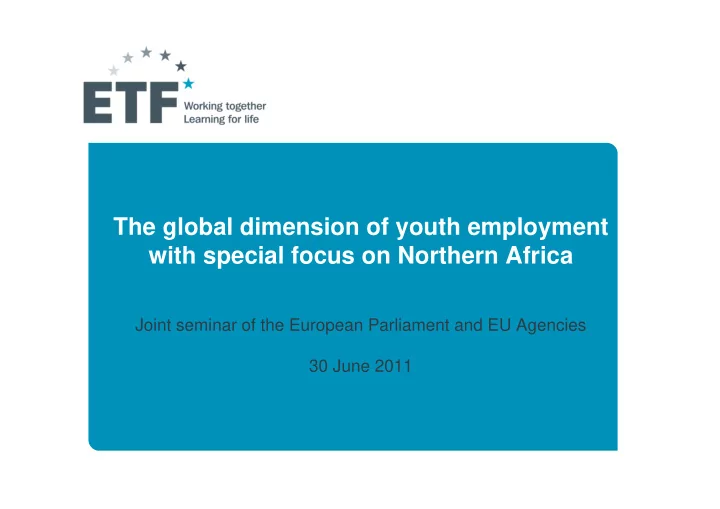

The global dimension of youth employment with special focus on Northern Africa Joint seminar of the European Parliament and EU Agencies 30 June 2011
ETF’s mission and vision � Mission To help transition and developing countries to harness the potential of their human capital through the reform of education, training and labour market systems in the context of the EU’s external relations policy. � Vision To make vocational education and training in the partner countries a driver for lifelong learning and sustainable development, with a special focus on competitiveness and social cohesion.
Potential candidate countries: Albania, Bosnia and Herzegovina, Kosovo (UNSCR 1244/1999), Serbia European Neighbourhood and Partnership Instrument countries ENP South: Algeria, Egypt, Jordan, Lebanon, Morocco, occupied Palestinian Territory, Syria, Tunisia and Israel ENP East: Armenia, Azerbaijan, Belarus, Georgia, Republic of Moldova, Ukraine and Russia
North Africa: Algeria, Egypt, Morocco, Tunisia Countries’ characteristics • Demographic pressure : young populations • Coexistence of a modern and traditional economic sector (including agriculture) • Large share of informal sector and small and medium sized enterprises • Territorial disparities • Centralised governance systems
Youth employment characteristics The “educated unemployed” : • university graduates have limited opportunities to find jobs corresponding to their expectations and qualifications • This is due partially to the lack of jobs and partially to skill miss- match The informal employment of low and middle qualified The vulnerability of illiterate youth – many of them women Migration
Unemployment rates Unemployment rates in North Africa 60% 54% 40% 31% 31% 31% 27% 24% 18% 14% 20% 16% 9% 14% 10% 0% Algeria ‘07 Egypt ‘08 Morocco ‘09 Tunisia ‘07 Sources: Meda-Ete database (AL,TN) Youth unemployment - Total Capmas et Observatory for Education Training Youth unemployment - Female and Employment (EGY); HCAP (MOR) Total Unemployment
Preparation for the labour market: Education and Training • Improved access to education - primary education (MDG’s) and path towards higher education • Still large numbers of young people remain deprived from E&T • Quality is lagging behind • Insufficient preparation for the labour market –normally education transfers academic knowledge • VET unattractive and of narrow scope – far from its European economic and social role • Active Labour market Measures: exist but their coverage is low - the focus on educated unemployed
The road ahead Concerted effort to (i) improve the relevance of skills of young people and enhance their employability, (ii) support job creation (SMEs; regional development; sectors) and (iii)improve the functioning of their labour markets by addressing segmentation.
Improving E & T and its relation to employment • Access, quality and relevance (of education at all levels) for employability • Increasing attractiveness of VET as valid educational pathway towards employment (more pressure on post-compulsory levels of education in the future) • The content of education : knowledge and key competences (entrepreneurship, citizenship, communication)
Improving E & T and its relation to employment • Bringing the world of education closer to the world of work with enterprise business cooperation – social partnership -(the sectoral approach) • Open the education and training institutions to stakeholders - Ensure inclusive governance – (all have interests - all have obligations – all have benefits) • Strengthening evidence-based policy making through monitoring developments in the demand and supply of skills, identifying skill gaps , ensure a better matching
Facilitating school-to-work transition • ALMMs as a means for skills adaptation, activation and work experience • Career guidance and counseling • Strengthening the role of public employment services EU/EU MSs /PCs enhanced co-operation
Recommend
More recommend